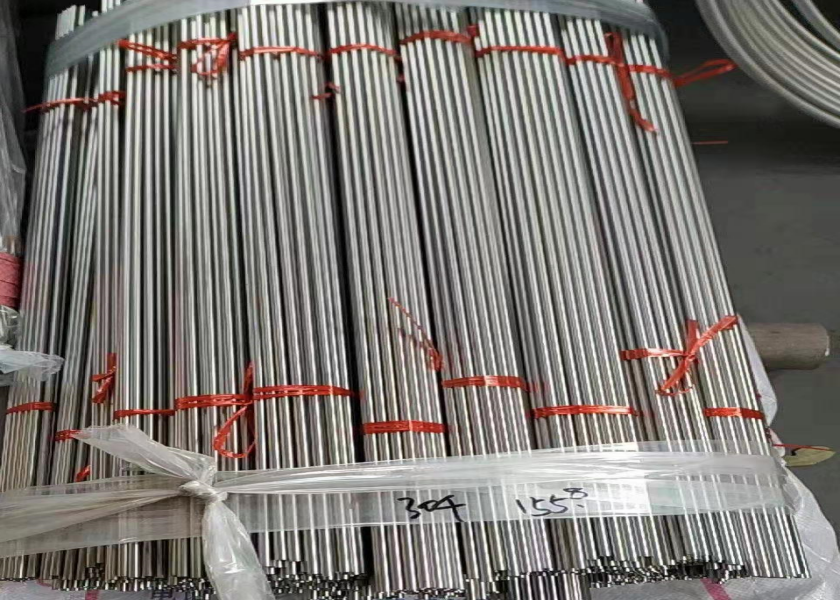316L stainless steel 4*0.5mm capillary tubing
| Standard | Steel Grade | ||||||||
|---|---|---|---|---|---|---|---|---|---|
| Chemical composition % | |||||||||
| C: | Mn: | Si: | P: | S: | Cr: | Ni: | Mo: | N: | |
| EN | 1.4401 – X5CrNiMo17-12-2 | ||||||||
| <0.07 | <2.0 | <1.0 | <0.045 | <0.015 | 16.5 – 18.5 | 10.0 – 13.0 | 2.0 – 2.5 | <0.11 | |
| EN | 1.4404 – X2CrNiMo17-12-2 | ||||||||
| <0.03 | <2.0 | <1.0 | <0.045 | <0.030 | 16.5 – 18.5 | 10.0 – 13.0 | 2.0 – 2.5 | <0.11 | |
| ASTM | AISI 316 – TP316 – UNS S31600 | ||||||||
| <0.08 | <2.0 | <1.0 | <0.045 | <0.030 | 16.0 – 18.0 | 10.0 – 14.0 | 2.0 – 3.0 | - | |
| ASTM | AISI 316L – TP316L – UNS S31603 | ||||||||
| <0.08 | <2.0 | <0.8 | <0.045 | <0.030 | 16.0 – 18.0 | 11.0 – 14.0 | 2.0 – 2.5 | - | |
| PN | 00H17N14M2 | ||||||||
| <0.03 | <2.0 | <0.8 | <0.045 | <0.030 | 16.0 – 18.0 | 12.0 – 15.0 | 2.0 – 2.5 | - | |
| GOST | 03Ch17N13M2 – 03Х17Н13М2 | ||||||||
| <0.03 | 1.0 – 2.0 | <0.4 | <0.030 | <0.020 | 16.8 – 18.3 | 13.5 – 15.0 | 2.2 – 2.8 | - | |
| NF | Z3CND17-11-02 | ||||||||
| <0.03 | <2.0 | <1.0 | <0.040 | <0.030 | 16.0 – 18.0 | 10.0 – 12.0 | 2.0 – 2.5 | - | |
| NF | Z7CND17-11-02 | ||||||||
| <0.07 | <2.0 | <1.0 | <0.040 | <0.030 | 16.0 – 18.0 | 10.0 – 12.0 | 2.0 – 2.5 | - | |
1.4404, 1.4401, AISI 316/L – application and specification
Austenitic stainless steel is resistant to intergranular corrosion, used mainly in environments containing harmful chlorides, acids and urea. 316/316L is the basic grade from the CrNiMo group with Molybdenum, the addition of which significantly increases the resistance to pitting and crevice corrosion of steel by 2-3 times.
Materials in grade 1.4404/1.4401 are suitable for use in the environment of phosphoric, nitric, citric, lactic, formic, acetic acids, in the presence of alkalis – hydroxides, and salts – nitrates, chlorides, fluorides, acetates and sulphates. The grade also shows resistance to the marine environment and salts. The steel is not resistant to chloric acid, orthophosphoric acid, formic acid in high concentrations, sulphuric acid and hydrochloric acid.
316L stainless steel 4*0.5mm capillary tubing
316 and 316L products are characterized by resistance to high temperatures, high plasticity, ductility, and relatively good ductility. They are suitable for compression, cold and tensile hardening to produce springs and spring elements from strips or wires. The materials show non-magnetic properties in soft condition, relatively good mechanical properties in cryogenic temperatures and good weldability not requiring additional heat treatment processes. It is also important to note the relatively low mechanical properties, which are not conducive to mechanical applications, and the difficult machinability of steel.
316L stainless steel 4*0.5mm capillary tubing
Steel 316/L as well as 1.4404/1.4401 is widely used in the oil, nitrogen, shipbuilding, chemical, construction, refinery, medical, cellulose, cryogenic, automotive, as well as food processing industries in the form of plates, tapes, pipes, sleeves, fittings, forgings, bars, for parts of gas installations, heat exchangers, railings, ship equipment and public transport vehicles, valves, tanks, pumps, radiators, food processing machines in dairy, catering, meat plants, vegetable and fruit processing plants, distillers, chimneys, steam systems, pipelines, pressure equipment, crystallizers, cisterns, silos, swimming pools, boiler parts, condensers, autoclaves, reactors or condensing equipment.
316L stainless steel 4*0.5mm capillary tubing








